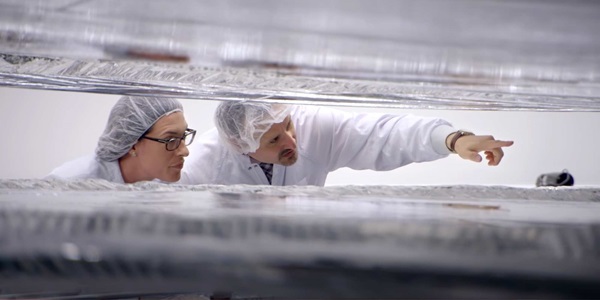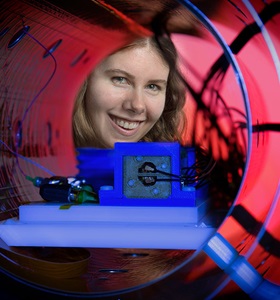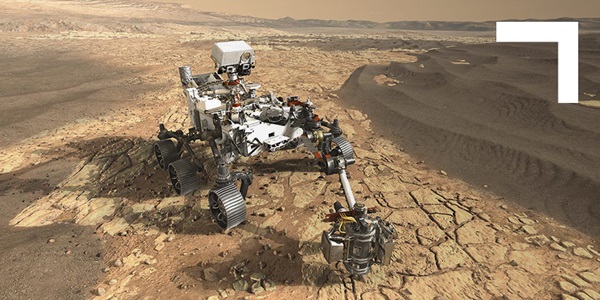The Coolest Technology: Cryocoolers

By Kelly McSweeney
Cryocoolers are machines that keep sensors extremely cold so that satellites and space telescopes can take pictures on long-term missions. Whether we're looking back toward Earth or outward into deep space, the sensors that capture images require extremely low temperatures. If sensors aren't cooled to cryogenic temperatures, they simply won't work. And if future missions such as the James Webb Space Telescope are going to scan the skies for evidence of the beginning of the universe, the imaging devices need constant, reliable cooling.
"It's not the device itself that I find so interesting," says John Russo, senior mechanical engineer in Northrop Grumman's cryocooler group. "It's what that device enables."
"Stars have exploded or burned up long ago, but that light is still traveling through space. That light will hit the primary mirror, bounce through the system and be focused onto the detector. And if the detector is at the right temperature, that light will be seen."
— John Russo, Senior Mechanical Engineer

Space Discoveries Enabled by Cryocooling
Russo explains that cooling technology lets us see the most detailed, highest-resolution pictures of the Earth from space ever taken. For example, Northrop Grumman's coolers are on the Advanced Himawari Imager (AHI) which is an instrument on the Japanese Meteorological Agency’s Himawari-8 and Himawari-9 satellites, which provides weather forecasts and observes the environment.
The cryocooler in the Hubble telescope helped to capture images which revealed that the universe is littered with billions of galaxies. Soon, its successor, the James Webb Space Telescope (Webb), will peer even deeper into space and further into history using long wavelength infrared sensing to detect the first stars and galaxies that formed after the Big Bang. "Being able to see what the universe looked like over 13.5 billion years ago is going to answer so many questions we have about space," Russo says.
Enable the MIRI
Northrop Grumman’s cryocoolers will enable the Mid-Infrared Instrument (MIRI) on Webb to answer many longstanding questions. It could uncover information about dark energy, a mysterious force that seems to be driving the expansion of the universe, although scientists don't understand it yet.
"It's going to be so sensitive that it can actually see exoplanets, or it can infer exoplanets around other stars in the universe," Russo says. He adds, "And Webb will be able to use spectroscopy to determine what the atmosphere of those planets are, so we'll be able to see telltale signs of life on other planets if it exists."
In order to see stars and galaxies that are millions and even billions of light-years away, you need a detector that can pick up distant evidence of light.
"When light hits a detector, it causes a photovoltaic response," says Russo.
Electrons start to flow, and by sensing those voltages and currents, we can recreate a picture of a distant galaxy. But if the sensor is too warm when the light hits it, those electrons won't flow, and we won't be able to process the image.

An Unusual High Tech Specialty
"Throughout human history, the Greeks, ancient Romans and people like Galileo have always looked up to the sky and wondered what's up there — or wanted to be up there looking down at Earth," says Russo. "Now we can do just that."
Cryocoolers is an unusual specialty, and Russo is a second-generation cryocooler engineer. As a child, he witnessed his father developing some of the world's first cryocoolers as an engineer.
"In 1979, my dad gave me a drawing of a Space Shuttle with a satellite in the payload bay," Russo says. "The cooler he was working on was in that satellite, and you can see it in the picture."
When the first imaging satellites launched in the 1960s, they used solid cryogen or frozen nitrogen to cool the sensors. The downfall of solid cooling is that the cryogen evaporates in three or four years, and then the mission is over.
"It's like putting ice in your cooler," Russo says, "Once all the ice melts, you're done."
Pioneers like Russo's father developed machines that could mechanically cool sensors down to a chilly 70 Kelvin (-333.67 degrees Fahrenheit). Now, with decades of research and development, Northrop Grumman's most advanced coolers, such as Webb's MIRI Cryocooler, can continuously cool to a ridiculously low 6.2 Kelvin (-448.51 degrees Fahrenheit).
"We have cryocoolers in orbit now that have been operating with no change in performance for over 20 years," Russo says.
He continued, “One way we show how reliable our coolers are is we add up the collective time they all have been operating on orbit. For instance, if there are ten coolers on orbit and they have all been operating for ten years, we’d say that’s 100 years of on-orbit operation. When you add up the entire number of hours that all Northrop Grumman coolers have been operating on-orbit that comes to just over 300 years of continuous on-orbit operation without a single failure.”
Keeping the Pulse on Cryocooler Development
Weighing just a dozen pounds, a typical cryocooler for space uses only as much power as a couple of standard light bulbs. It comprises a pulse tube cold head and a patented compressor. In the 1990s, Northrop Grumman engineers collaborated with researchers at Oxford University to develop technology that gives the cryocooler more heat lift for less power and less weight than others.
Earlier cryocoolers had a mechanical piston to compress and expand gas, which would then cool down and absorb heat from a load, such as the imaging sensors on a satellite. But mechanical pistons can wear out and stop working.
Russo explains, "Rather than having a mechanical piston compressing and expanding the gas, we use a pulse tube, which is a gas column for compressing and expanding a column of gas, which in essence is acting like a piston, but it has no moving parts."
Plus, the cryocooler compressors have a non-contacting design so that they don't wear out, even when they are operating for decades at a time. These intrinsic design features provide the high reliability and enable long mission life.
"It's not the device itself that I find so interesting. It's what that device enables."
— John Russo, Senior Mechanical Engineer
Enabling Deep Space Exploration
The most exciting discoveries that cryocoolers will enable are facts about the universe that we can't even imagine yet. Yes, astronomers will be looking for exoplanets and dark energy, and they will also be watching and waiting to find out what else we don't understand about the universe.
Soon, the James Webb Space Telescope will be looking out at deep space, waiting for light. "Stars have exploded or burned up long ago, but that light is still traveling through space," Russo says. "That light will hit the primary mirror, bounce through the system and be focused onto the detector. And if the detector is at the right temperature, that light will be seen."
More innovation stories
Read all stories about advanced technology and innovation >>


